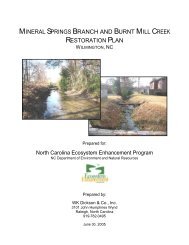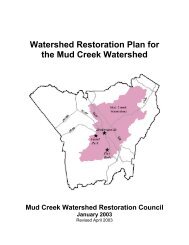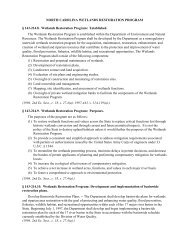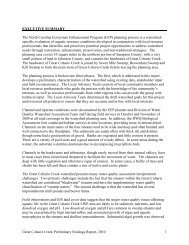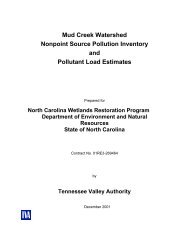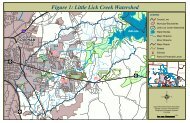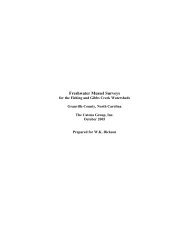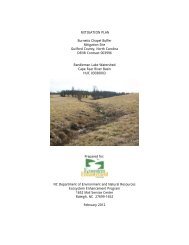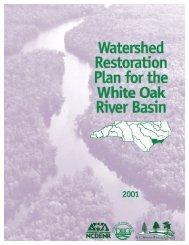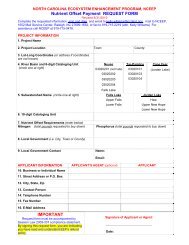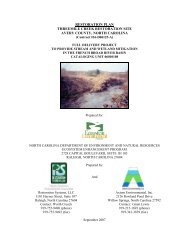RESTORATION PLAN Glade Creek Stream Restoration Alleghany ...
RESTORATION PLAN Glade Creek Stream Restoration Alleghany ...
RESTORATION PLAN Glade Creek Stream Restoration Alleghany ...
You also want an ePaper? Increase the reach of your titles
YUMPU automatically turns print PDFs into web optimized ePapers that Google loves.
Bog turtles inhabit slow, shallow, muck-bottomed rivulets of sphagnum bogs, calcareous fens,marshy/sedge-tussock meadows, spring seeps, wet cow pastures, and shrub swamps; the habitatusually contains an abundance of sedges or mossy cover. The turtles depend on a mosaic ofmicrohabitats for foraging, nesting, basking, hibernation, and shelter (USFWS, 2000). "Unfragmentedriparian systems that are sufficiently dynamic to allow the natural creation of open habitat are neededto compensate for ecological succession" (USFWS, 2000). Beaver, deer, and cattle may beinstrumental in maintaining the essential open-canopy wetlands (USFWS, 2000).Bog turtles rarely leave wetland habitats, although recent radio-telemetry evidence indicates that bogturtles sometimes venture into and across upland habitats (375 m, Carter et al., 2000) and cross roadsto reach adjacent wetlands (Morrow et al. 2001). Whitlock (unpublished data) also documentedindividuals regularly moving back and forth across 1 km of a typical wetland habitat to more suitablehabitat patches. Successful movement across developed areas is probably negligible, due tosusceptibility to collection, predation, and road mortality.In North Carolina over somewhat less than 1 year, distances between relocations of radio-taggedturtles ranged from 0 to 87 m (mean= 24 m) for males, and 0 to 62 m (mean= 16 m) for females(Herman and Fahey, 1992).There are 5 delineated wetlands on the project site, and they are all forested (refer to Section 5.1 andFigure 4), While these forested wetlands are not preferred habitat of the bog turtle, based on currentscientific knowledge, they could be used by turtles as they travel between more suitable or preferredhabitat. Based on personal communication with Dennis Herman of the N.C. Dept. of TransportationOffice of the Natural Environment (July 20, 2007), a recognized bog turtle expert, bog turtlesprobably travel through the site on their way upstream or downstream to other sites, and may use theproject site wetlands as stopping-over points. However, since all wetland areas within the project sitewill be undisturbed during project construction and will be permanently preserved, he stated that hebelieved that the short term disturbance of project construction would be offset by the long termpreservation of the wetlands. Therefore, stream restoration activities associated with the <strong>Glade</strong> <strong>Creek</strong><strong>Stream</strong> Mitigation site in <strong>Alleghany</strong> County will have no negative effect on the bog turtle species.2.6 Cultural ResourcesA visual on-site assessment was conducted by traversing the entire project site thoroughly, on bothsides of the streams. No archeological artifacts were observed or noted during the site survey. TheEnvironmental Data Resources, Inc. review for the project site revealed no record of mapped historicsites within the project area.The State Historical Preservation Office (SHPO) was contacted and conducted a review of the site. Ina response dated March 27, 2007 it was stated that SHPO was not aware of any historic resources thatwould be affected by the restoration project and that SHPO had no comment on the proposedundertaking.A formal letter was sent to the Tribal Historic Preservation Office of the Eastern Band of CherokeeIndians on February 22, 2007. The project is still under review and when the letter is received, it willbe submitted to EEP.13




